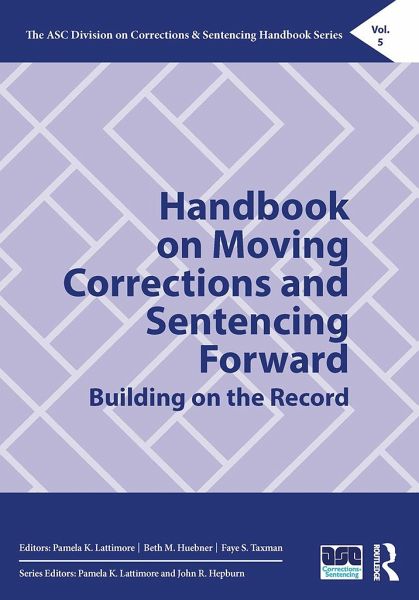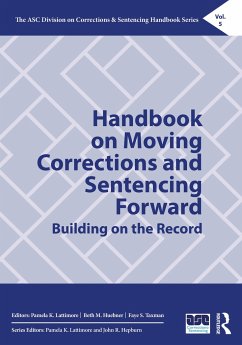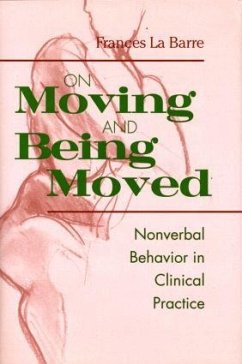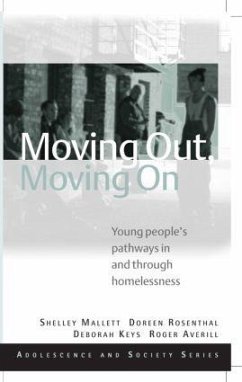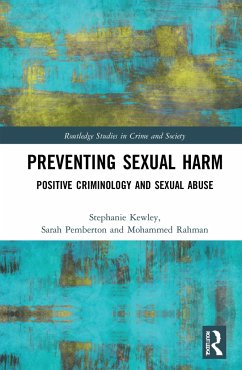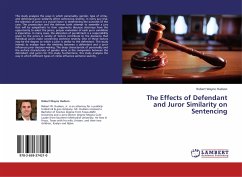Broschiertes Buch
Handbook on Moving Corrections and Sentencing Forward
Building on the Record
Herausgeber: Lattimore, Pamela K.; Taxman, Faye S.; Huebner, Beth M.
Versandkostenfrei!
Versandfertig in 1-2 Wochen
Weitere Ausgaben:

PAYBACK Punkte
29 °P sammeln!




This volume addresses major issues and research in corrections and sentencing with the goal of using previous research and findings as a platform for recommendations about future research, evaluation, and policy.
Pamela K. Lattimore, Ph.D., is Senior Director for Research Development for RTI's Division for Applied Justice Research with responsibility for leading multidisciplinary research focused on improving understanding of crime and the criminal justice system. She has more than 30 years of experience evaluating interventions, investigating the causes and correlates of criminal behavior, and developing approaches to improve criminal justice operations. Dr. Lattimore has led multiple multisite, multimodal evaluations, including the NIJ-funded evaluations of the Honest Opportunity Probation with Enforcement Demonstration Field Experiment, a multisite randomized controlled trial to study the effectiveness of swift and certain sanctions to improve probationer outcomes, and the Multisite Evaluation of the Serious and Violent Offender Reentry Initiative, a quasi-experimental evaluation of 16 adult and juvenile prisoner reentry programs. Dr. Lattimore is principal investigator for the research for the Arnold Ventures' funded Advancing Pretrial Policy and Research, which focuses on improving pretrial risk assessment and outcomes, and is leading an NIJ-funded project to develop, test, and implement the Integrated Dynamic Risk Assessment for Community Supervision (IDRACS), an artificial intelligence (AI) tool that will incorporate dynamic risk factors and indicators of supervision practice to more effectively model the risk posed by people under community supervision. She is a past Chair of the American Society of Criminology Division on Corrections and Sentencing, a Fellow of the Academy of Experimental Criminology, and a recipient of the American Correctional Association Peter P. Lejins Researcher Award, the American Society of Criminology Division on Corrections and Sentencing Distinguished Scholar Award, and the Academy of Experimental Criminology Joan McCord Award for distinguished experimental contributions to criminology and criminal justice. Beth M. Huebner, Ph.D., is a professor in the Department of Criminology and Criminal Justice at the University of Missouri-St. Louis. Her principal research interests include the collateral consequences of incarceration, racial and gender disparities in the criminal justice system, and public policy. She is currently serving as co-principal investigator for the St. Louis County MacArthur Safety + Justice Challenge and collaborating on a study of monetary sanctions in Missouri with funding from the Arnold Foundation. She is the past chair of the Division on Corrections and Sentencing for the American Society of Criminology and Vice-President Elect of the American Society of Criminology. Faye S. Taxman, Ph.D., is a university professor at George Mason University. She is a health service criminologist recognized for her work in the development of seamless systems-of-care models that link the criminal justice system with health care and other service delivery systems and reengineering probation and parole supervision services. She has conducted experiments to examine different processes to improve treatment access and retention, to assess new models of probation supervision consistent with RNR frameworks, and to test new interventions. She has active "laboratories" with numerous agencies including Virginia Department of Corrections, Alameda County Probation Department (CA), Hidalgo County Community Corrections Department (TX), North Carolina Department of Corrections, and Delaware Department of Corrections. She developed the translational RNR Simulation Tool (www.gmuace.org/tools) to assist agencies to advance practice. Dr. Taxman has published more than 200 articles. She is author of several books, including Implementing Evidence-Based Community Corrections and Addiction Treatment (2012, with Steven Belenko). She is Co-Editor of Health & Justice. In 2018, she was appointed a fellow of the American Society of Criminology (ASC). In 2019, she received the Lifetime Achievement award from the American Society of Criminology's Division of Sentencing and Corrections, which has recognized her as Distinguished Scholar twice as well as conferred on her the Rita Warren and Ted Palmer Differential Intervention Treatment Award. She received the Joan McCord Award in 2017 from ASC's Division of Experimental Criminology. She has also received numerous awards from practitioner organizations such as the American Probation and Parole Association and Caron Foundation. Dr. Taxman earned her Ph.D. from Rutgers University's School of Criminal Justice.
Produktdetails
- Verlag: Routledge
- Seitenzahl: 428
- Erscheinungstermin: 30. Mai 2022
- Englisch
- Abmessung: 254mm x 178mm x 23mm
- Gewicht: 800g
- ISBN-13: 9780367566715
- ISBN-10: 0367566710
- Artikelnr.: 64103237
Herstellerkennzeichnung
Libri GmbH
Europaallee 1
36244 Bad Hersfeld
gpsr@libri.de
Für dieses Produkt wurde noch keine Bewertung abgegeben. Wir würden uns sehr freuen, wenn du die erste Bewertung schreibst!
Eine Bewertung schreiben
Eine Bewertung schreiben
Andere Kunden interessierten sich für




